03.Instruction Set Architecture(ISA)
Instruction Set Architecture(ISA)
The “contract” between software and hardware
Functional definitionof operations, modes, and storage locations supported by hardwarePrecise descriptionof how software can invoke and access them
Strictly speaking, ISA is the architecture
Informally, architecture is also used to talk about the big picture of implementation
Better to call this
microarchitecture
Microarchitecture (微架构)
ISA specifies what hardware does, not how it does
No guarantees regarding
How operations are implemented
Which operations are fast and which are slow
Which operations take more power and which take less
These issues are determined by the microarchitecture
Microarchitecture = how hardware implements architecture
All Pentiums implement the x86 architecture
与ISA有关的内容
The Von Neumann model
Implicit(隐含) structure of all modern ISAs
Format
Length and encoding
Operations
Operand model
Where are operands(操作数) stored and how do address them?
Datatypes and operations
Control
我们用的例子: MIPS ISA
1. Von Neumann Model
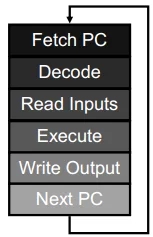
Implicit model of all modern ISAs
Key:
program counter (PC)Defines total order of dynamic instructions
Next PC is PC++ unless insn says otherwise
Order and
named storagedefine computationValue flows from insn X to Y via storage A iff…
X names A as output, Y names A as input…
And Y after X in total order
Processor logically executes loop at left
Instruction execution assumed atomic
Instruction X finishes before insn X+1 starts
2. Instruction Format
Length (长度)
Fixed length(固定长度)
32 or 64 bits
Simple implementation: compute next PC using only PC
Code density
Variable length
Complex implementation
Code density
Compromise: two lengths
Example: MIPS_16
Encoding (编码)
A few simple encodings simplify decoder implementation
Complex encoding can improve code density
MIPS Format (指令格式)
Length
32-bits
MIPS_16: 16-bit variants of common instructions for density
Encoding
3 formats, simple encoding
Q: how many operation types can be encoded in 6-bit opcode?

R Format (寄存器类型)

e.g., add $1, $2, $3
000000
00010
00011
00001
00000
100000
alu-rr
2
3
1
zero
add/signed
注: $1 表示 1 号寄存器. 忽视 shamt.
I Format (立即数类型)

All loads and stores use I-format
Assembly: lw $1, 100($2)
Machine:
100011
00010
00001
0000000001100100
lw
2
1
100 (in binary)
注: 100($2) 表示基址为 2 号寄存器, 加上 100 偏移量. lw 为 load word, 取 100($2) 地址的值, 置于 $1.
ALU ops with immediates
addi $1, $2, 100
001000 00010 00001 0000000001100100
注: [00001] <= [00010] + 0000000001100100, 即 $1 = $2 + 0000000001100100.
Conditional branches
beq $1, $2, 7
000100 00001 00010 0000 0000 0000 0111
PC = PC + (0000 0000 0000 0111 << 2)
// word offset
注: 条件跳转指令, if $1 == $2, goto 7. 7 为偏移量.
J Format (跳转类型)
Direct Jump:
opcode
addr
6
26
Jump to:
New PC = 4 MSB of PC || addr || 00
4+26+2 = 32 bits for jump target
注: MSB 为高四位(most significant bit).
3. Operations
Operation type encoded in instruction
opcodeMany types of operations
Integer arithmetic: add, sub, mul, div, mod/rem (signed/unsigned)
FP arithmetic: add, sub, mul, div, sqrt
Integer logical: and, or, xor, not, sll, srl, sra
...
What other operations might be useful?
More operation types == better ISA?
DEC VAX computer had LOTS of operation types
E.g., instruction for polynomial evaluation (no joke!)
But many of them were rarely/never used
4. Operand Model (操作数模型)
If you’re going to add, you need at least 3 operands
Two source operands, one destination operand
Question #1: Where can operands come from?
Question #2: And how are they specified?
Running example: A = B + C
Several options for answering both questions
Discuss:
Memory-Only&RegistersOptional:
Accumulator&Stack
Operand Model I: Memory Only
Memory only
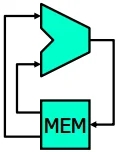
Operand Model II: Accumulator
Accumulator : implicit single-element stack
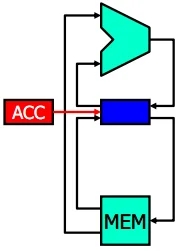
注: Accumulator 相比 Memory Only, 减少了访存.
Operand Model III: Stack
Stack : top of stack (TOS) is implicit in instructions
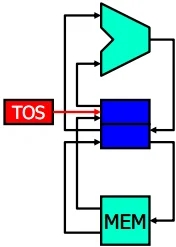
注: Stack 相比 Accumulator, 有更多的存储单元(Acc 只有 1 个).
Operand Model IV: Registers
General - purpose registers : multiple explicit accumulators
Load - store : GPR and only loads/stores access memory

注: Registers 相比 Stack, 读写位置任意.
Operand Model: Pros and Cons
Metric I:
static code sizeNumber of instructions needed to represent program, size of each
Evaluation: memory only(1) < register(3) < load-store(4)
Metric II:
data memory trafficNumber of bytes moved to and from memory
Evaluation: load-store > register > memory only
Metric III:
instruction latencyWant low latency to execute instructions
Evaluation: load-store > register > memory only
现状: Most current ISAs are load-Store
MIPS Operand Model
MIPS is load-store
32 32-bit integer registers
Actually 31: r0 is hardwired to value 0 -> why?
32 32-bit FP registers
Can also be treated as 16 64-bit FP registers
HI, LO: destination registers for multiply/divide
Integer register conventions
Allows separate function-level compilation and fast function calls
Memory Addressing (内存寻址)
ISAs assume
“virtual” address sizeEither 32 or 64 bits
Program can name 2^32 bytes (4GB) or 2^64 bytes (16PB)
ISA point? no room for even one address in a 32-bit instruction
Addressing mode : way of specifying address
Direct: ld R1,(R2) R1=mem[R2]
Displacement: ld R1,8(R2) R1=mem[R2+8]
Indexed: ld R1,(R2,R3) R1=mem[R2+R3]
Memory-indirect: ld R1,@(R2) R1=mem[mem[R2]]
Auto-update: ld R1,8(R2) R2+=8; R1=mem[R2]
Scaled: ld R1,(R2,R3,32,8) R1=mem[R2+R3*32+8]
What high-level program idioms are these used for?
MIPS Addressing Modes: Rationality
MIPS implements only displacement
Why? Experiment on VAX (ISA with every mode) found distribution
Disp: 61%, reg-ind: 19%, scaled: 11%, mem-ind: 5%, other: 4%
80% use displacement or register indirect (=displacement 0)
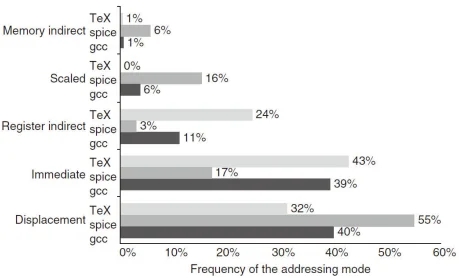
How about the remain 20%?
I-type instructions: 16-bit displacement

Is 16-bits enough?
Yes! VAX experiment showed 1% accesses use displacement >16
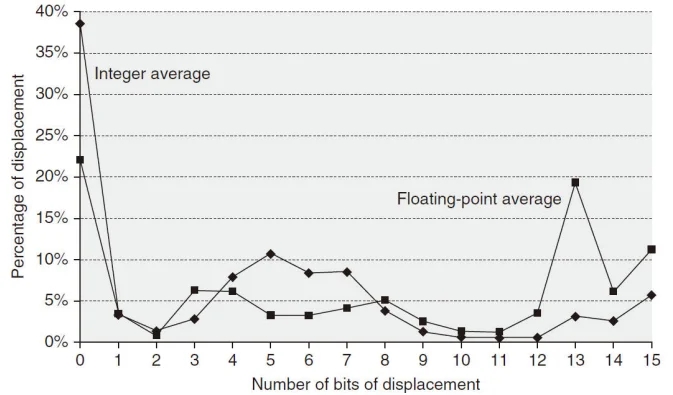
Addressing Issue: Endian - ness
Byte Order (字节序)
Big Endian: byte 0 is 8mostsignificant bitsIBM 360/370, Motorola 68k, MIPS, SPARC, HP PA-RISC
Little Endian: byte 0 is 8leastsignificant bitsIntel 80x86, DEC Vax, DEC/Compaq Alpha


Addressing Issue: Alignment
Alignment: require that objects fall on address that is multiple of their size
32-bit integer
Aligned if address % 4 = 0 [% is symbol for “mod”]
Aligned: lw @XXXX
00Not: lw @XXXX
10
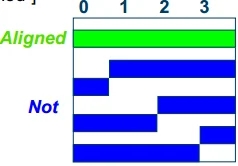
Question: what to do with unaligned accesses (uncommon case)?
Support in hardware? Makes all accesses slow
Trap to software routine? Possibility
MIPS? ISA support: unaligned access using two instructions:
lw @XXXX10 = lwl @XXXX10 / lwr @XXXX10
5. Datatypes
Datatypes
Software view: property of data
Hardware view:
data is just bits, property of operations
Hardware datatypes
Integer: 8 bits (byte), 16b (half), 32b (word), 64b (long)
IEEE754 FP: 32b (single-precision), 64b (double-precision)
Packed integer: treat 64b int as 8 8b int’s or 4 16b int’s
MIPS Datatypes (and Operations)
Datatypes: all the basic ones (byte, half, word, FP)
All integer operations read/write 32-bits
No partial dependences on registers
Only byte/half variants are load-store
lb, lb
u, lh, lhu, sb, sh
Loads sign-extend (or not) byte/half into 32-bits
Operations: all the basic ones
Signed/unsigned variants for integer arithmetic
Immediate variants for all instructions
add, addu, addi, addiu
Regularity/orthogonality: all variants available for all operationsMakes compiler’s “life” easier
6. Control
6.1 Control Instructions I
One issue: testing for conditions
Option I: Compare and branch instructions
blti $1,10,targetSimple,
– two ALUs: one for condition, one for target address
Option II: Implicit condition codes
subi $2,$1,10 // sets “negative” CCbn targetCondition codes set “for free”,
– implicit dependence is tricky
Option III: Condition registers, separate branch insns
slti $2,$1,10bnez $2,targetAdditional instructions, one ALU per, explicit dependence
MIPS Conditional Branches
MIPS uses combination of options II and III
Compare 2 registers and branch: beq, bne
Equality and inequality only
Don’t need an adder for comparison
Compare 1 register to zero and branch: bgtz, bgez, bltz, blez
Greater/less than comparisons
Don’t need adder for comparison
Set explicit condition registers: slt, sltu, slti, sltiu, etc.
Why?

6.2 Control Instructions II
Another issue: Computing targets
Option I: PC-relative
Position-independent within procedure
Used for branches and jumps within a procedure
Option II: Absolute
Position independent outside procedure
Used for procedure calls
Option III: Indirect (target found in register)
Needed for jumping to dynamic targets
Used for returns, dynamic procedure calls, switches, ???
How far do you need to jump?
Typically not so far within a procedure (they don’t get that big)
Further from one procedure to another
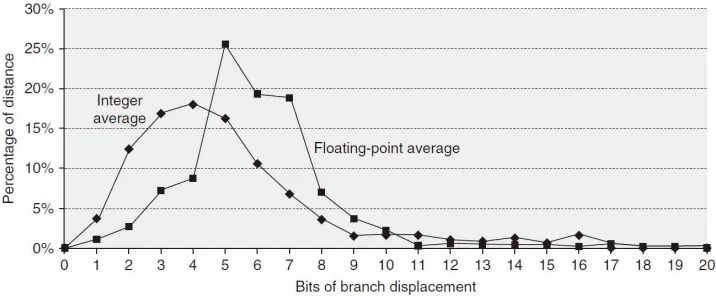
MIPS Control Instructions
MIPS uses all three
PC-relative -> conditional branches:
bne, beq, blez, etc.16-bit relative offset, <0.1% branches need more
PC = PC + 4 + immediate if condition is true (else PC=PC+4)

Absolute -> unconditional jumps:
j target26-bit offset (can address 2^28 words < 2^32 -> what gives?)

Indirect -> Indirect jumps:
jr $rd
6.3 Control Instructions III
Another issue: how to support procedure calls?
We “link” (remember) address of the calling instruction + 4 (current
PC + 4) so we can return to it after the procedure
MIPS
Implicitreturn address register is$ra(=$31)Direct jump-and-link:
jal address-> $ra = PC+4; PC = address
Can then return from call with:
jr $raOr can call with indirect jump-and-link:
jalr $rd, $rs -> $rd = PC+4; PC = $rs // explicit return address registerThen return with:
jr $rd
Control习语: If - Then - Else
Understanding programs helps with architecture
Know what common programming idioms look like in assembly
Why? How can you MCCFif you don’t know what CC is?
First control idiom:
if - then - else
What's the MIPS format?
Control习语: Arithmetic For Loop
Second idiom:
for loop with arithmetic induction
RISC vs. CISC
RISC: reduced-instruction set computerCoined by P+H in early 80’s
CISC: complex-instruction set computerNot coined by anyone, term didn’t exist before “RISC”
Religious war (one of several) started in mid 1980’s
RISC (MIPS, Alpha) “won” the technology battles
CISC (IA32 = x86) “won” the commercial war
Compatibility a stronger force than anyone (but Intel) thought
Intel beat RISC at its own game … more on this soon
Intel 80x86 ISA (aka x86 or IA - 32 now)
Long history
Binary compatibility across generations <- IBM 360
1978: 8086, 16-bit, registers have dedicated uses
1980: 8087, added floating point (stack)
1982: 80286, 24-bit
1985: 80386, 32-bit, new instrs GPR almost
1989-95: 80486, Pentium, Pentium II
1997: Added MMX instructions (for graphics)
1999: Pentium III
2002: Pentium 4
2004: “Nocona” 64-bit extension (to keep up with AMD)
Intel x86: The Penultimate CISC (VAX ultimate)
Variable length instructions: 1-16 bytes
Few registers: 8 and each one has a special purpose
Multiple register sizes: 8,16,32 bit (for backward compatibility)
Accumulators for integer instrs, and stack for FP instrs
Multiple addressing modes: indirect, scaled, displacement
Register-register, memory - register insns
Condition codes
Instructions for memory stack management (push, pop)
Instructions for manipulating strings (entire loop in one instruction)
Summary: yuck!
80x86 Registers and Addressing Modes
Eight 32-bit registers (not truly general purpose)
EAX, ECX, EDX, EBX, ESP, EBP, ESI, EDI
Six 16-bit Registers for code, stack, & data
2-address ISA
One operand is both source and destination
NOT a Load/Store ISA
One operand can be in memory
80x86 Addressing Modes
Register Indirect
mem[reg]
not ESP or EBP
Base + displacement (8 or 32 bit)
mem[reg + const]
not ESP or EBP
Base + scaled index
mem[reg + (2^scale x index)]
scale = 0,1,2,3
base any GPR, index not ESP
Base + scaled index + displacement
mem[reg + (2^scale x index) + displacement]
scale = 0,1,2,3
base any GPR, index not ESP
Condition Codes
x86 ISA has condition codes
Special HW register that has values set as side effect of instruction execution
Example conditions
Zero
Negative
Example use
subi $t0, $t0, 1
bz loop
80x86 Instruction Encoding
Variable size 1-byte to 16-bytes
Jump (JE) 2-bytes
Push 1-byte
Add Immediate 5-bytes
W bit says 32-bits or 8-bits
D bit indicates direction
memory -> reg or reg -> memory
movw EBX, [EDI + 45]
movw [EDI + 45], EBX
Decoding x86 Instructions
Is a nightmare!
Instruction length is variable from 1 to 16 bytes!
Prefixes, postfixes
Crazy “formats” -> register specifiers move around
But key instructions not terrible
Yet, everything
mustwork correctly
How x86 Won Anyway
X86 won because it was the first 16-bit chip by 2 years
IBM put it into its PCs because no competing choice
Software written to x86 so x86 is the standard
Hard to complete with Intel
X86 is difficult ISA to implement
Intel can amortize(缓冲) design effort over vast salesIntel uses RISC “underneath”
Moore’s law has helped in a big way
Most engineering problems can be solved with more transistors
Last updated